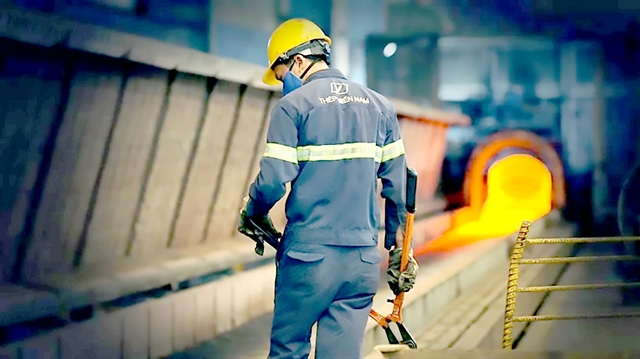 |
| A worker at the Southern Steel Company. The local steel industry is expected to expand this year. — VNA/VNS Photo |
HÀ NỘI — The domestic steel industry is seeing a positive growth trend, projected to increase by 7-8 per cent this year.
According to the Vietnam Steel Association (VSA), the total production capacity for crude steel is around 23 million tonnes, while the capacity for finished steel products, including construction steel, hot and cold rolled coils, galvanised sheets and pipes, is approximately 38.6 million tonnes per year. This year, finished steel production is expected to hit 30 million tonnes, reflecting a 7 per cent rise from 2023. However, this recovery remains uncertain due to ongoing challenges.
The current state of steel production in Việt Nam is facing significant challenges due to oversupply and increased imports, leading to fierce price competition for domestic steel products.
According to Nghiêm Xuân Đa, Chairman of the Vietnam Steel Association (VSA), hot rolled steel (HRC) imports have surged, with April 2024 seeing 890,000 tonnes imported, 1.5 times the total domestic production. Notably, 71 per cent of this imported HRC comes from China.
In the first four months of 2024, Việt Nam imported a total of 3.93 million tonnes of HRC, marking a 32 per cent increase compared to the same period in 2023 and equating to 159 per cent of the domestic HRC production volume.
Imports from China alone amounted to 2.9 million tonnes, more than double the imports from the same period in 2023. This marks the first time that Việt Nam’s HRC imports have exceeded domestic production within a year.
The influx of imports has adversely affected the production output of Việt Nam’s two domestic HRC producers, Formosa and Hòa Phát. Their production has decreased to 73 per cent of design capacity, down from 86 per cent in 2021, largely due to unfair competition from imported goods sold below cost. Import prices have also fallen sharply, from $613 per tonne at the beginning of 2023 to $541 per tonne by the end of the year.
The situation has led to a significant decline in the domestic market share of Formosa and Hòa Phát, dropping from 45 per cent in 2021 to 30 per cent in 2023. The trend of increasing imports is expected to persist, potentially undermining efforts to produce high-quality steel autonomously in Việt Nam.
Phan Đăng Tuất, Chairman of the Vietnam Supporting Industry Association, highlighted the historical context of the trading picture, noting that Việt Nam initially imported HRC due to the high investment and technological requirements of producing it domestically. However, with the investments by Formosa Hà Tĩnh and Hòa Phát in HRC production, Việt Nam can now produce competitive products. Despite this, the continued large-scale importation of HRC, especially at prices below production costs, poses a serious threat to domestic production and market stability.
Trade remedies needed
Việt Nam’s steel industry, despite being a significant player globally and the leading producer in the ASEAN region, faces several challenges that hinder its long-term development. Key issues include a heavy reliance on imported rolled steel, which makes up over 50 per cent of total import turnover, particularly hot rolled steel. In addition, imports of shaped steel, metal-plated and colour-coated products account for about 20-25 per cent of domestic consumption demand.
To address these challenges, the Vietnam Steel Association has recommended that relevant agencies enhance the regulatory framework and establish stringent technical and quality management standards. This initiative aims to prevent substandard steel products from entering the Vietnamese market, ensuring they meet technical safety and environmental criteria.
The Ministry of Industry and Trade has been urged to implement trade remedies to combat unfair competition and safeguard domestic production. Furthermore, the ministry is expediting the development of the Vietnam Steel Industry Development Strategy, which targets completion by 2030 with a vision extending to 2050. This strategy will incorporate policies aimed at promoting green and sustainable growth within the steel industry.
In the absence of a finalised steel industry development strategy, measures are being proposed to manage investments in large-scale steel projects. These are intended to balance supply and demand, prevent resource wastage, protect land capital, minimise environmental impacts, reduce greenhouse gas emissions and promote green production and consumption practices. – VNS
- Reduce Hair Loss with PURA D’OR Gold Label Shampoo
- Castor Oil Has Made a “Huge” Difference With Hair and Brow Growth
- Excessive hair loss in men: Signs of illness that cannot be subjective
- Dịch Vụ SEO Website ở Los Angeles, CA: đưa trang web doanh nghiệp bạn lên top Google
- Nails Salon Sierra Madre
 VnExpress News The News Gateway of Vietnam
VnExpress News The News Gateway of Vietnam




